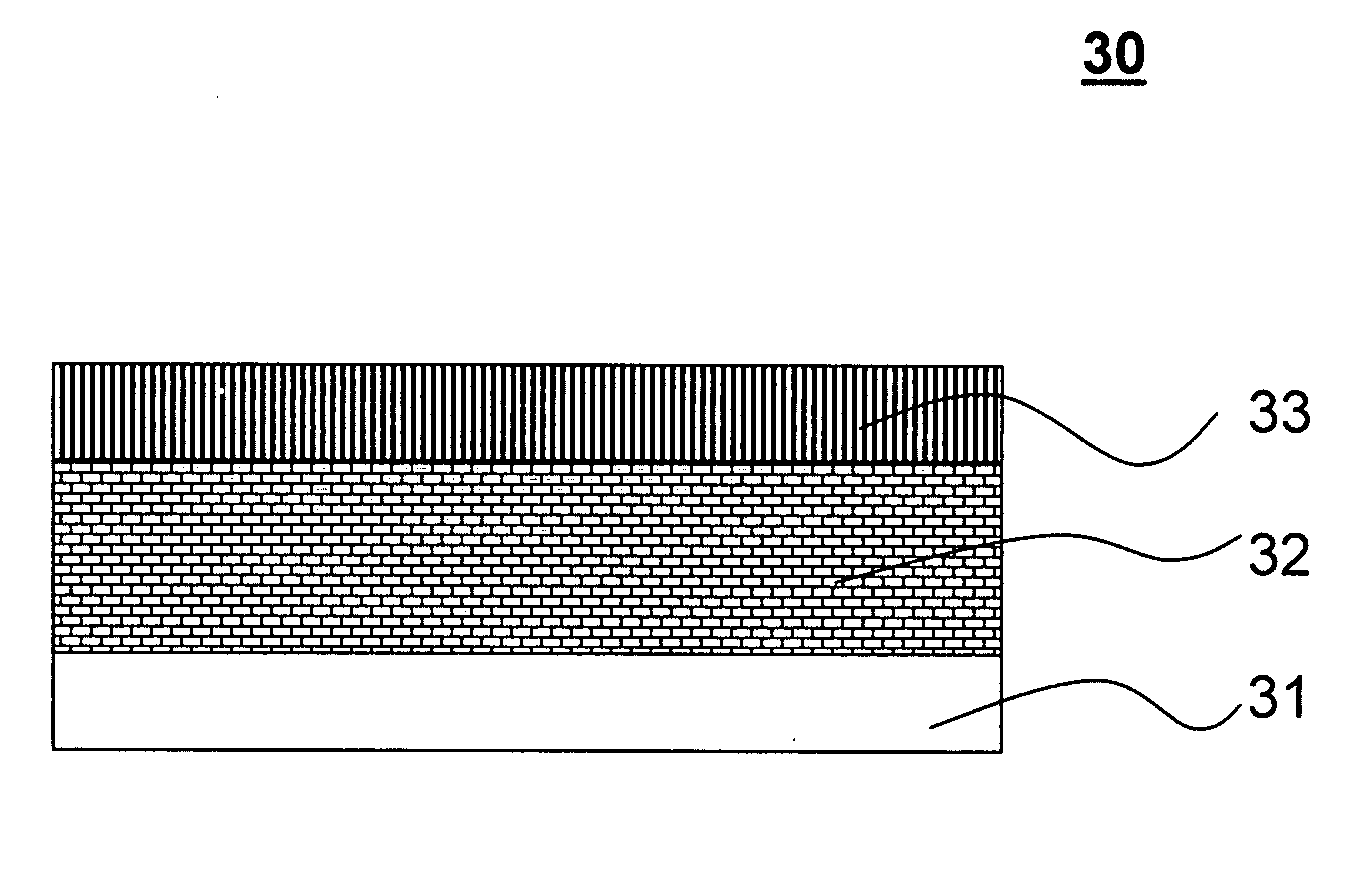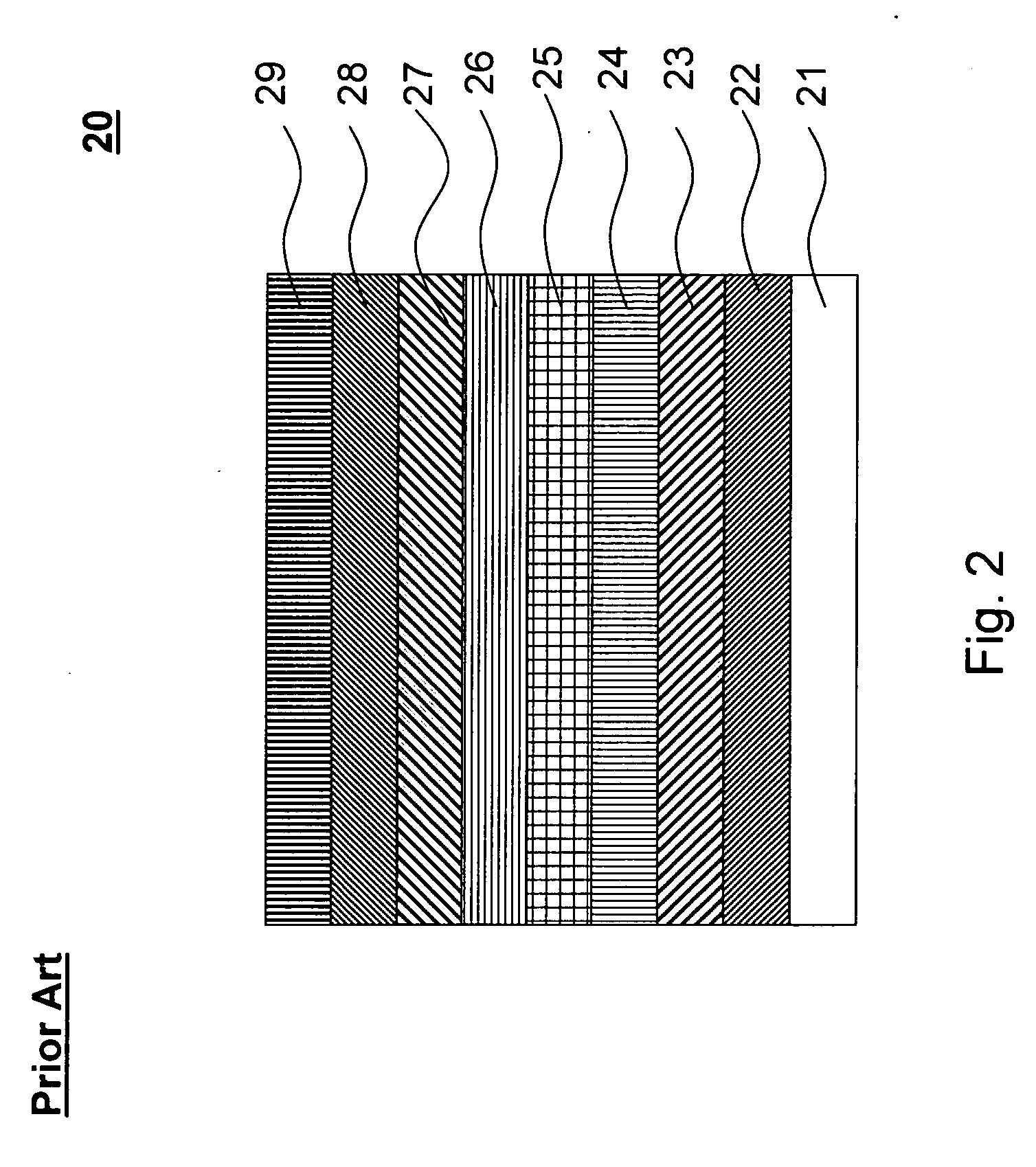All-in-one organic electroluminescent inks with balanced charge transport properties
an electroluminescent ink and all-in-one technology, applied in the field of organic semiconductor devices, can solve the problems of high production cost and low production yield, limited success of the fpd market of the oled, and complex device configuration, and achieve the effect of improving the morphology of the all-in-one organic film
- Summary
- Abstract
- Description
- Claims
- Application Information
AI Technical Summary
Benefits of technology
Problems solved by technology
Method used
Image
Examples
example 1
Synthesis of an Electro-Luminescent Compound, DPVBi
4,4′-Bis[(diethyl phosphate)methyl]biphenyl
[0047]Under nitrogen atmosphere, 25.12 g of 4,4′-bis(chloromethyl)-1,1′-biphenyl (100 mmol.) and 100 ml of triethyl phosphite were charged together in a dried 3-neck flask (250 ml) equipped with a reflux condenser, a gas inlet, and an electronic thermometer. It immediately caused a beige suspension. The suspension was heated and stirred for two hours at 130° C. The solution was continued to be stirred for another four hours at 130° C. After it cooling down to room temperature, it was kept in a refrigerator for overnight. The resulting gray precipitate was filtered, thoroughly washed with cool hexane (5×50 ml), and dried under suction and then put in a vacuum oven for two hours at 65° C. Finally, 39.43 g of a beige crystal was collected (86.8%).
Characterization of the Crystal:
[0048]m.p.: 103-109° C.
[0049]FTIR (KBr, cm−1): 3041, 2980, 14995, 14405, 1392, 1245, 1035, 961, 864, 831, 772, 736, 5...
example 2
Synthesis of Electron-Transport Component, OVI588
1,3,5-tris(4-flluorobiphenyl-4′-yl)benzene
[0058]In 3-neck round-bottom flask (250 ml) filled with nitrogen, 100 ml of freshly-distilled THF and 20 ml of de-ionized water were poured and degassed with nitrogen bubbles for 30 minutes. 0.78 g of tetramethylamonium bromide was added as a phase transfer agent. 0.33 g of palladium acetate and 1.8 g of triphenylphosphine were added and the resulting suspension was stirred for a half of hour to activate the catalysts. 2.42 g of 1,3,5-tris(4-bromophenyl)benzene and 2.65 g of 4-fluorophenylboronic acid were then added and the resulting mixture was heated to reflux before adding 7.2 g of sodium carbonate. The solution was heated to reflux for 48 hours to complete the reaction. After cooled down to room temperature, the reaction mixture was transferred into a separation funnel and water was separated. The separated organic layer was again washed by water (2×20 ml) and dried with sodium sulfate an...
example 3
Synthesis of Hole-Transport Material, OVI544
9-(4-methoxyphenyl)carbazole
[0059]A 1,000 ml 3-neck flask equipped with a Dean Starks trap, a water condenser and a magnetic stirrer was flame dried with a torch under nitrogen and cooled down to room temperature. 300 ml of anhydrous o-xylene was poured into the flask and degassed with nitrogen bubble for 30 minutes. 41.8 g of carbazole and 58.51 g of 4-iodoanisole were added and heated to yield a clear brown solution. 2.48 g of copper chloride and 4.5 g of 1,10-phenanthroline were then added, followed by 14.1 g of potassium hydroxide. After refluxed for 3 hours, another 14.1 g of potassium hydroxide was added and the resulting mixture was continued to reflux for another 20 hours and it was cool down to room temperature. After the reaction mixture was transferred into a separation funnel, it was washed by water (3×100 ml), dried with sodium sulfate and filtered to yield 46.3 g of flakes. 39.5 g of final product was obtained after a re-crys...
PUM
| Property | Measurement | Unit |
|---|---|---|
| Volume | aaaaa | aaaaa |
| Volume | aaaaa | aaaaa |
| Volume | aaaaa | aaaaa |
Abstract
Description
Claims
Application Information
 Login to View More
Login to View More - R&D
- Intellectual Property
- Life Sciences
- Materials
- Tech Scout
- Unparalleled Data Quality
- Higher Quality Content
- 60% Fewer Hallucinations
Browse by: Latest US Patents, China's latest patents, Technical Efficacy Thesaurus, Application Domain, Technology Topic, Popular Technical Reports.
© 2025 PatSnap. All rights reserved.Legal|Privacy policy|Modern Slavery Act Transparency Statement|Sitemap|About US| Contact US: help@patsnap.com



